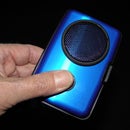Introduction: Simulated Fireworks Wheel
This Instructable is about how to make wheel that throws sparks like a large fireworks pinwheel but it doesn't use any powders or fireworks. Depending on how the laws are written in your area this may or may not be defined as a firework. The science behind it is the oxidation of finely divided iron in the form of grade 0000 steel wool. The wheel rotates by means of a geared-down electric motor.
Parts needed:
3 - 2x4 wood pieces (8 feet long) 4 - 3/8" carriage bolts 6" long
6 or 12 Volt gear motor with .375 inch diameter shaft and 50 to 150 RPM output speed.
Battery appropriate for the motor, common light switch SPST, wiring, screws, wood glue, etc.
Front bike wheel, steel wool, soft iron wire
First I collected an old front bicycle wheel. The hub has a hole in it which was just under .375 inches and I had a 12 Volt gear motor with a .375 shaft. Drill out the hub to that size and either pin or epoxy the wheel to the shaft (I used epoxy and so far it still works well). Mount the motor to the top end of a 2x4 about 5 feet long. Use sheet rock screws and wood glue. This will be the upper mast of a 2 piece wheel stand. Using more 2x4s and carriage bolts cut a lower mast about 5 feet long and bolt on a 3 foot front and back leg and a left and right leg to create a fully supported stand. When you set up the wheel stand tighten the bolts holding the legs in place so that they sit firmly on the ground. See picture above.
Step 1: Install Battery, Switch and Join the Masts
Run a wire down the top mast section from the motor to a switch and a battery. Mount a shelf near the lower end for the battery. I used a 12V gel cell but any battery that will run your motor will do. A simple single pole switch is wired into one of the two wires going from the battery to the motor. I used a simple household light switch that I had in my junk box as they are easy to mount with 2 sheet rock screws and the terminals have large brass screws to hold the wires.
Overlap the lower 8 inches of the upper mast on the upper 8 inches of the lower mast and temporarily clamp them together. Now drill 2 holes about 6 inches apart large enough for 3/8" carriage bolts. These will hold the masts together. Install the bolts and remove the clamp.
If you used epoxy to join the wheel to the motor allow 24 hours before testing the motor.
Test by switching on the current and insure the wheel spins nicely without much vibration. It does not matter which direction the wheel spins.
Step 2: Load the Wheel With Steel Wool
So far I have found that grade 0000 steel wool works best. This is available at all home stores as it is used for furniture finishing. Usually it is in the paint department. It is made in pads about 6 inches long. One pad will burn for about 20 seconds when hung from the wheel (depending on wheel speed). You can stitch 2 or more pads end to end by using soft steel mechanics wire and pushing it through the pads and then twist the wire ends to hold it.
Push a 6 inch length of wire through one end of a pad and wrap around the wheel rim with a twist to bind it to the wheel. In this way the pad(s) are hung from the wheel. For a better effect hang more of these pads around the wheel. They will take fire from the first one as the wheel gets moving.
Step 3: Fire Your Wheel!
Set up the wheel stand in a large area such as a green lawn with at least 50 feet from anything that might catch fire or be damaged by sparks (such as a car finish). Your audience should also be about 50 feet away for best viewing.
Lighting the wheel: There are 2 ways to light the steel wool. You can simply use a flame such as a match or paper taped to a pole and light the lower end of one of the hanging pads. Or, if you are doing a display and want to light it remotely you can use a momentary switch with a battery, long wire and 2 alligator clips attached to the pad bottom about an inch or two apart. Either way the steel wool will instantly turn orange. Immediately switch on the wheel and walk away to enjoy the view. In the video I used a different method to attach the pads that was too tightly bound to the rim and the effect was not as good as free-hanging pads.
Video available at
http://youtu.be/Xb1O6-NnAYY
Enjoy!












